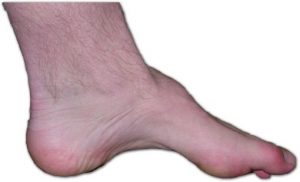 DEFINITION
DEFINITION
Charcot-Marie-Tooth, or CMT, is inherited peripheral neuropathy and is found worldwide among all races and ethnic groups. Discovered in 1886, CMT affects an estimated 2.6 million people.
CMT usually isn’t life-threatening and almost never affects brain function. It is not contagious, but it is hereditary and can be passed down from one generation to the next.
CMT patients slowly lose normal use of their extremities as nerves degenerate and muscles weaken because the affected nerves no longer stimulate the muscles. Many patients also have some loss of sensory nerve functions.
SYMPTOMS
Although there are many different genetic causes of CMT, all types tend to have remarkably similar symptoms.
- A high arched foot is generally one of the first signs of this disorder, although in some instances extremely flat feet are also typical of CMT.
- As the disease progresses, structural foot deformities take place. The patient may develop a pes cavus (high-arched) foot and hammertoes.
- The progressive muscle wasting of CMT also leads to problems with walking, running, and balance. Ankle weakness and sprains are common, and many patients develop foot drop.
- Later in the course of the disease, hand function may become affected. Tasks requiring manual dexterity become difficult. The loss of nerve function is often accompanied by tingling and burning sensations in the hands and feet. This usually causes little more than mild discomfort, but some people experience severe neuropathic pain and require medication to control it.
- Weakness of the respiratory muscles is in rare in people with CMT, but when present, it can cause life-threatening problems. If shortness of breath is an issue, a patient should be checked by a respiratory specialist to see if the use of a ventilator is recommended.
It is important to note that the severity of symptoms can vary greatly from patient to patient, even within the same family. A child may or may not be more severely disabled than his/her parent. Some family members may experience significant impairment and require bracing while others have no noticeable symptoms but are found to have CMT upon examination by EMG or nerve conduction studies.
TREATMENT
 Although there is no cure for CMT at the present time, there are many therapies that can greatly improve life and function for CMT patients.
Although there is no cure for CMT at the present time, there are many therapies that can greatly improve life and function for CMT patients.
- Physical therapy can maintain what movement, muscle strength and flexibility they have.
- Many people benefit from occupational therapy which helps people accomplish the tasks of daily living with the use of assistive devices.
- Bracing is another non-invasive form of correcting problems caused by CMT. Often gait abnormalities can be corrected by the use of either hinged or unhinged, braces called AFOs (ankle-foot orthoses). These braces help control foot drop and ankle instability and often provide a better sense of balance for patients.
- Appropriate footwear is important for people with CMT, but they often have difficulty finding well-fitting shoes because of their high arched feet and hammered toes. Falls can generally be avoided by watching where one walks and by wearing appropriate footwear.
- It is important for CMT patients to control their weight. Not only does extra weight make physical activity more difficult, but it also increases the stress on already compromised joints and muscles.
- Patients should try to maintain as much strength and flexibility as possible. Generally, patients should consult a physical therapist or physician before beginning an exercise program, and avoid strenuous activity and overwork. Moderate activity and physical exercise can be beneficial, but patients must be conscious of their physical limitations.
- Finally, stress management is important in maintaining a healthy body.
Any disabling condition can affect the way people think and feel about themselves, but having a chronic illness like CMT, which is often unseen, places stress on individuals and often causes depression. People with CMT can suffer from low self-esteem and relationships with others can be affected.
If the problem persists, consult your doctor.


